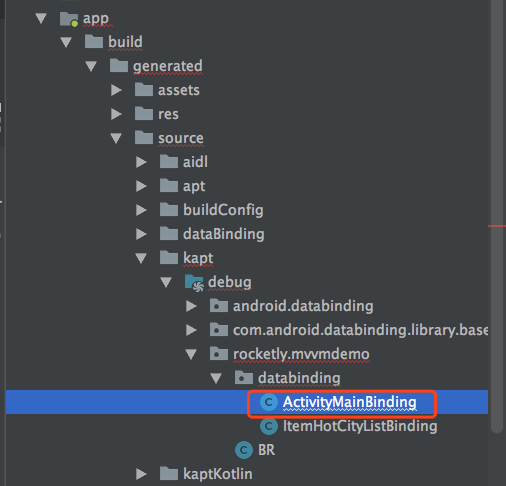關於Android MvvM的一些體會
關於Android MvvM的一些體會
前言
由於我司專案較老有很多歷史包袱程式碼結構也比較混亂,需求複雜的頁面動輒activity中1000多行,看著很是頭疼,於是趁著加班提前做完需求餘下的時間學習了mvvm對專案部分功能進行了改造,目前已經使用3個版本了,本篇博文分享下我使用的感受。
準備
這裡先說說關於mvvm的幾個問題(如有不對請輕噴 (╹▽╹))
-
首先說說我為啥選擇mvvm而不是熟知的mvp。
主要原因是我覺得mvp介面寫起來有點麻煩,針對ui和model都得寫介面,然後這個粒度不好控制如果太細了就得寫一堆介面,太粗了又沒有複用性,並且presenter持有了ui引用在更新ui的時候還得考慮生命週期,還有activity引用的處理防止記憶體洩露這些問題我都覺得挺麻煩的而MvvM中databinding框架處理好了這些問題,所以我選擇了更加方便的mvvm,當然mvvm也不是沒有缺點下面會說到。
-
mvvm優缺點
- 優點:
- 資料來源被強化,利用databinding框架實現雙向繫結技術,當資料變化的時候ui自動更新,ui上使用者操作資料自動更新,很好的做到資料的一致性。
- xml和activity處理ui操作、model提供資料、vm處理業務邏輯,各個層級分工明確,activity中程式碼大大減少專案整體結構更加清晰。
- 很方便做ui的a/b測試可以共用同一個vm。
- 方便單元測試ui和vm邏輯完全分離。
- 缺點:
- bug很難被除錯,資料繫結使得一個bug被傳遞到別的位置,要找到bug的原始位置不太容易。
- 由於要遵守模式的規範呼叫流程變得複雜。
- vm中會有很多被觀察者變數如果業務邏輯非常複雜會消耗更多記憶體。
- 優點:
-
mvvm一定要用databinding麼?
答案是 否。首先我們要了解到mvvm是資料驅動的架構,所以著眼點是資料的變化,那麼我們需要實現一套ui和資料雙向繫結的邏輯,當資料修改的時候通知ui改變,ui輸入或者點選的時候觸發資料修改,而databinding就是幫你實現這個雙向繫結過程的框架,在xml中按它的語法去寫佈局,然後他會根據你在xml中所寫的生成對應的類幫你實現這個繫結過程,當然你也可以自己手動實現這個繫結過程,所以databinding是非必須的。
專案結構圖

上面是mvvm基本的結構圖,act/fra和xml是v處理ui操作、viewmodel是vm處理業務邏輯、repository是m提供資料,他們之間是一種單項的持有關係activity/fragment持有vm,vm持有model。
對於Repository不太理解的可以看看這篇文章Repository模式
實際使用
專案中我使用的是retrofit+rxjava+livedata+viewmodel+databinding+kotlin實現的mvvm
retrofit+rejava用來在model層從網路獲取資料通知到vm
livedata是vm通知ui時使用可以感知生命週期防止記憶體洩漏npe問題(主要用在事件傳遞上)
viewmodel是vm可以在act/frg因配置修改銷燬的情況下複用
databinding實現ui和vm的雙向繫結
這裡來個具體例子,activity可見通知vm獲取資料,vm從model拿到資料然後更新被觀察者,ui自動重新整理的流程。
<?xml version="1.0" encoding="utf-8"?>
<layout xmlns:app="http://schemas.android.com/apk/res-auto">
<data>
<variable
name="vm"
type="rocketly.mvvmdemo.viewmodel.HotCityListVM" />
</data>
<android.support.v4.widget.SwipeRefreshLayout xmlns:android="http://schemas.android.com/apk/res/android"
xmlns:tools="http://schemas.android.com/tools"
android:id="@+id/srl"
android:layout_width="match_parent"
android:layout_height="match_parent"
app:onRefreshListener="@{()->vm.onRefresh()}"//重新整理自動觸發vm.onRefresh()方法
tools:context="rocketly.mvvmdemo.ui.MainActivity">
<android.support.v7.widget.RecyclerView
android:id="@+id/rv"
android:layout_width="match_parent"
android:layout_height="match_parent"
app:multiTypeItem="@{vm.cityList}"//這裡rv與vm中cityList繫結 />
</android.support.v4.widget.SwipeRefreshLayout>
</layout>
xml中Recyclerview和vm的cityList繫結
class MainActivity : AppCompatActivity() {
lateinit var binding: ActivityMainBinding
override fun onCreate(savedInstanceState: Bundle?) {
super.onCreate(savedInstanceState)
binding = DataBindingUtil.setContentView<ActivityMainBinding>(this, R.layout.activity_main).apply {
vm = ViewModelProviders.of(this@MainActivity).get(HotCityListVM::class.java)
}
}
override fun onResume() {
super.onResume()
binding.vm?.onFirstLoad()//onResume呼叫vm.onFirstLoad()載入資料
}
}
activity在onResume通知vm載入資料
class HotCityListVM : BaseVM() {
val cityList = ObservableArrayList<Basic>()
val hotCityItemEvent = SingleLiveEvent<String>()
override fun onFirstLoad() {
super.onFirstLoad()
load()
}
override fun onRefresh() {
super.onRefresh()
load()
}
private fun load() {
CityRepository.getHotCityList(num = 50)
.subscribe(ApiObserver(success = {
resetLoadStatus()
cityList.clear()
cityList.addAll(it.HeWeather6[0].basic)
}, error = {
resetLoadStatus()
}))
}
fun hotCityItemClick(s: String) {
hotCityItemEvent.value = s
}
}
vm從model CityRepository獲取資料修改被觀察者物件cityList,然後ui監聽到資料修改執行recyclerview重新整理,這一套流程就走完了,具體例子在MvvmDeno。
除了正常的請求資料顯示邏輯,這裡再演示下點選事件的流程,彈dialog或者其他需要context的事件也是同樣方式。
recyclerview中item點選事件傳遞到vm然後vm通知activty執行對應的邏輯。
<?xml version="1.0" encoding="utf-8"?>
<layout xmlns:app="http://schemas.android.com/apk/res-auto"
xmlns:tools="http://schemas.android.com/tools">
<data>
<variable
name="vm"
type="rocketly.mvvmdemo.viewmodel.HotCityListVM" />
<variable
name="data"
type="rocketly.mvvmdemo.model.Basic" />
</data>
<android.support.constraint.ConstraintLayout xmlns:android="http://schemas.android.com/apk/res/android"
android:layout_width="match_parent"
android:layout_height="50dp"
android:onClick="@{()->vm.hotCityItemClick(data.location)}"//呼叫vm的方法通知點選了>
<TextView
android:id="@+id/tv_city_name"
android:layout_width="wrap_content"
android:layout_height="wrap_content"
android:text="@{data.location}"
android:textColor="@android:color/black"
android:textSize="18sp"
app:layout_constraintBottom_toBottomOf="parent"
app:layout_constraintHorizontal_chainStyle="packed"
app:layout_constraintLeft_toLeftOf="parent"
app:layout_constraintRight_toLeftOf="@+id/tv_lon"
app:layout_constraintTop_toTopOf="parent"
tools:text="上海" />
<TextView
android:id="@+id/tv_lon"
android:layout_width="wrap_content"
android:layout_height="wrap_content"
android:layout_marginLeft="5dp"
android:text="@{data.lon}"
android:textColor="@android:color/black"
android:textSize="14sp"
app:layout_constraintBottom_toBottomOf="parent"
app:layout_constraintLeft_toRightOf="@+id/tv_city_name"
app:layout_constraintRight_toLeftOf="@+id/tv_lat"
app:layout_constraintTop_toTopOf="parent"
tools:text="(經度:555" />
<TextView
android:id="@+id/tv_lat"
android:layout_width="wrap_content"
android:layout_height="wrap_content"
android:layout_marginLeft="2dp"
android:text="@{data.lat}"
android:textColor="@android:color/black"
android:textSize="14sp"
app:layout_constraintBottom_toBottomOf="parent"
app:layout_constraintLeft_toRightOf="@+id/tv_lon"
app:layout_constraintRight_toRightOf="parent"
app:layout_constraintTop_toTopOf="parent"
tools:text="緯度:555)" />
</android.support.constraint.ConstraintLayout>
</layout>
class HotCityListVM : BaseVM() {
val hotCityItemEvent = SingleLiveEvent<String>()//給activty監聽的被觀察者livedata物件
fun hotCityItemClick(s: String) {//點選方法
hotCityItemEvent.value = s
}
}
class MainActivity : AppCompatActivity() {
lateinit var binding: ActivityMainBinding
override fun onCreate(savedInstanceState: Bundle?) {
super.onCreate(savedInstanceState)
binding = DataBindingUtil.setContentView<ActivityMainBinding>(this, R.layout.activity_main).apply {
vm = ViewModelProviders.of(this@MainActivity).get(HotCityListVM::class.java)
}
initListener()
}
private fun initListener() {
binding.vm?.apply {
hotCityItemEvent.observe(this@MainActivity) {//監聽item點選事件
it ?: return@observe
Toast.makeText(this@MainActivity, "點選了:$it", Toast.LENGTH_SHORT).show()
}
}
}
}
以前我們都是在item中直接執行點選事件的,但為了遵守mvvm的規範,邏輯都在vm處理又因為vm不能持有context所以需要context的事件在通過livedata傳遞到activity執行。
那麼一般的資料請求和點選事件的流程就講完了,接下來說說databinding原理。
DataBinding原始碼淺析
通過前面的例子可以發現對於databinding的使用一般可以分為如下幾步
- 在xml中按databinding的語法書寫佈局
- activity中使用
DataBindingUtil.setContentView()繫結View並獲取binding物件 - 把xml中宣告的變數通過第二步得到的binding物件設定進去
第一步按databinding語法書寫xml,然後聲明瞭一個變數vm,並將rv與vm的cityList繫結,重新整理監聽與vm的onRefresh方法繫結
<?xml version="1.0" encoding="utf-8"?>
<layout xmlns:app="http://schemas.android.com/apk/res-auto">
<data>
<variable
name="vm"
type="rocketly.mvvmdemo.viewmodel.HotCityListVM" />
</data>
<android.support.v4.widget.SwipeRefreshLayout xmlns:android="http://schemas.android.com/apk/res/android"
xmlns:tools="http://schemas.android.com/tools"
android:id="@+id/srl"
android:layout_width="match_parent"
android:layout_height="match_parent"
app:onRefreshListener="@{()->vm.onRefresh()}"
tools:context="rocketly.mvvmdemo.ui.MainActivity">
<android.support.v7.widget.RecyclerView
android:id="@+id/rv"
android:layout_width="match_parent"
android:layout_height="match_parent"
app:multiTypeItem="@{vm.cityList}" />
</android.support.v4.widget.SwipeRefreshLayout>
</layout>
然後make project會生成一個佈局名稱+Binding的類,生成的路徑如下

這個類就是按我們xml中所寫生成的,這裡把完整的生成類貼出來可以大概的看下。
public class ActivityMainBinding extends android.databinding.ViewDataBinding implements android.databinding.generated.callback.OnRefreshListener.Listener {
@Nullable
private static final android.databinding.ViewDataBinding.IncludedLayouts sIncludes;
@Nullable
private static final android.util.SparseIntArray sViewsWithIds;
static {
sIncludes = null;
sViewsWithIds = null;
}
// views
@NonNull
public final android.support.v7.widget.RecyclerView rv;
@NonNull
public final android.support.v4.widget.SwipeRefreshLayout srl;
// variables
@Nullable
private rocketly.mvvmdemo.viewmodel.HotCityListVM mVm;
@Nullable
private final android.support.v4.widget.SwipeRefreshLayout.OnRefreshListener mCallback2;
// values
// listeners
// Inverse Binding Event Handlers
public ActivityMainBinding(@NonNull android.databinding.DataBindingComponent bindingComponent, @NonNull View root) {
super(bindingComponent, root, 1);
final Object[] bindings = mapBindings(bindingComponent, root, 2, sIncludes, sViewsWithIds);
this.rv = (android.support.v7.widget.RecyclerView) bindings[1];
this.rv.setTag(null);
this.srl = (android.support.v4.widget.SwipeRefreshLayout) bindings[0];
this.srl.setTag(null);
setRootTag(root);
// listeners
mCallback2 = new android.databinding.generated.callback.OnRefreshListener(this, 1);
invalidateAll();
}
@Override
public void invalidateAll() {
synchronized(this) {
mDirtyFlags = 0x4L;
}
requestRebind();
}
@Override
public boolean hasPendingBindings() {
synchronized(this) {
if (mDirtyFlags != 0) {
return true;
}
}
return false;
}
@Override
public boolean setVariable(int variableId, @Nullable Object variable) {
boolean variableSet = true;
if (BR.vm == variableId) {
setVm((rocketly.mvvmdemo.viewmodel.HotCityListVM) variable);
}
else {
variableSet = false;
}
return variableSet;
}
public void setVm(@Nullable rocketly.mvvmdemo.viewmodel.HotCityListVM Vm) {//根據我們xml中宣告的vm變數生成的set方法
this.mVm = Vm;
synchronized(this) {
mDirtyFlags |= 0x2L;
}
notifyPropertyChanged(BR.vm);
super.requestRebind();
}
@Nullable
public rocketly.mvvmdemo.viewmodel.HotCityListVM getVm() {
return mVm;
}
@Override
protected boolean onFieldChange(int localFieldId, Object object, int fieldId) {
switch (localFieldId) {
case 0 :
return onChangeVmCityList((android.databinding.ObservableArrayList<rocketly.mvvmdemo.model.Basic>) object, fieldId);
}
return false;
}
private boolean onChangeVmCityList(android.databinding.ObservableArrayList<rocketly.mvvmdemo.model.Basic> VmCityList, int fieldId) {
if (fieldId == BR._all) {
synchronized(this) {
mDirtyFlags |= 0x1L;
}
return true;
}
return false;
}
@Override
protected void executeBindings() {
long dirtyFlags = 0;
synchronized(this) {
dirtyFlags = mDirtyFlags;
mDirtyFlags = 0;
}
rocketly.mvvmdemo.viewmodel.HotCityListVM vm = mVm;
android.databinding.ObservableArrayList<rocketly.mvvmdemo.model.Basic> vmCityList = null;
if ((dirtyFlags & 0x7L) != 0) {
if (vm != null) {
// read vm.cityList
vmCityList = vm.getCityList();
}
updateRegistration(0, vmCityList);
}
// batch finished
if ((dirtyFlags & 0x7L) != 0) {
// api target 1
rocketly.mvvmdemo.utils.databinding.DataBindingExKt.setItem(this.rv, vmCityList);
}
if ((dirtyFlags & 0x4L) != 0) {
// api target 1
this.srl.setOnRefreshListener(mCallback2);
}
}
// Listener Stub Implementations
// callback impls
public final void _internalCallbackOnRefresh(int sourceId ) {
// localize variables for thread safety
// vm != null
boolean vmJavaLangObjectNull = false;
// vm
rocketly.mvvmdemo.viewmodel.HotCityListVM vm = mVm;
vmJavaLangObjectNull = (vm) != (null);
if (vmJavaLangObjectNull
